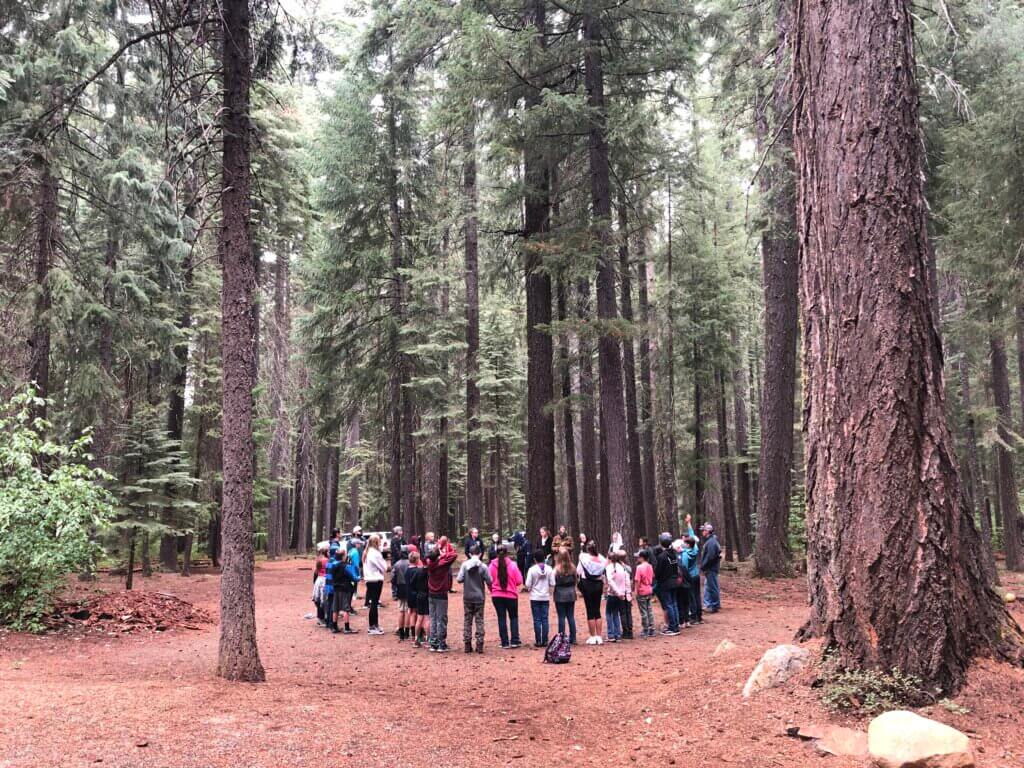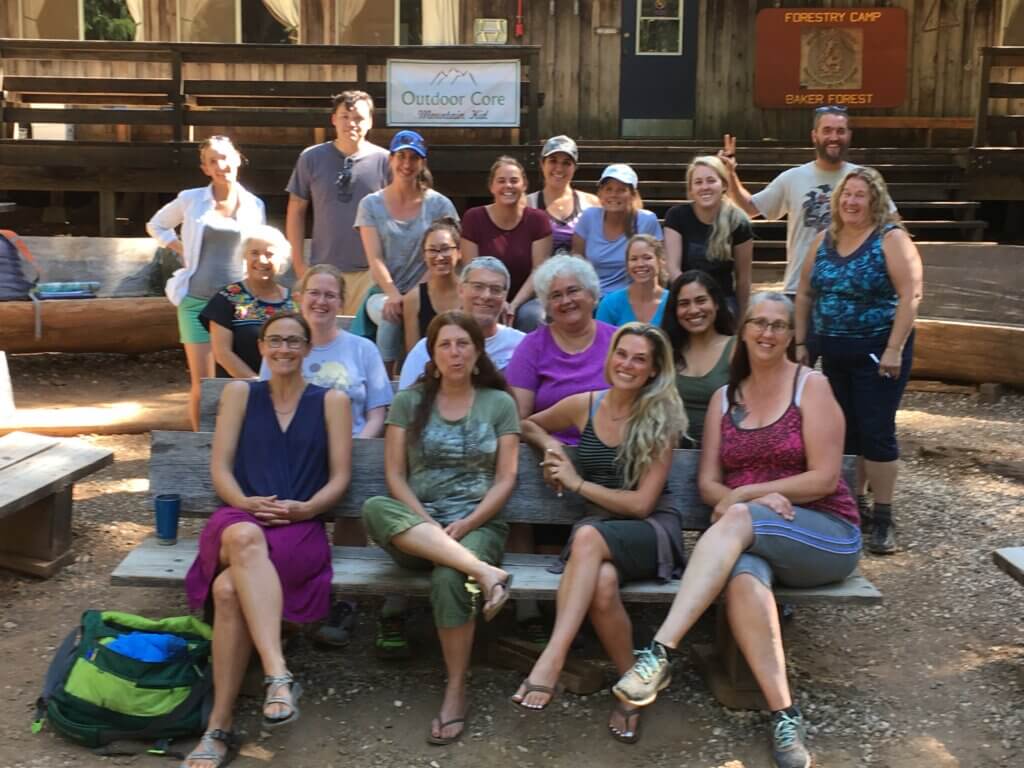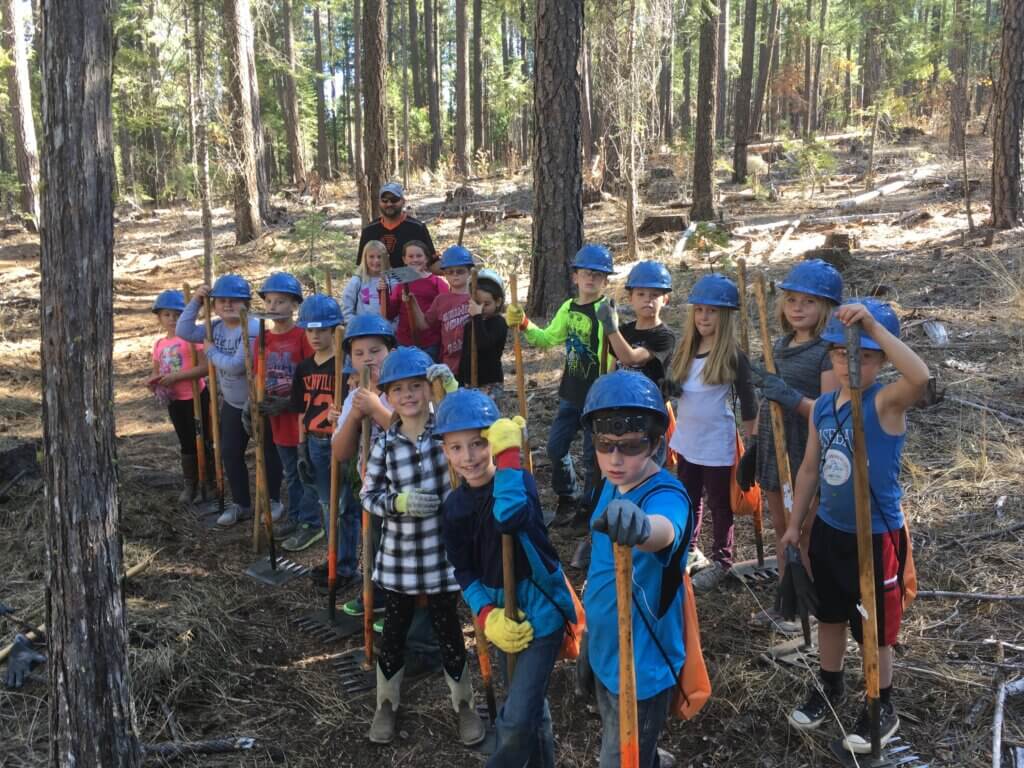It’s the first week of the school year, and I’m at Kids Creek Forest, one of our Learning Landscape properties identified by teachers and conserved by the Feather River Land Trust. I’m meeting with Lynee Crawford, a botanist and GIS specialist for the Plumas National Forest, to update a map of the 145-acre site, adding more names of places and features: the Lightning Tree, the Fire Tree, the Disco Tree, and the Trident Tree. These, along with the creek and other property features, have been named by the Mountain Kids who attend C. Roy Carmichael Elementary School in Portola, California. We check the distances of the Cattail Trail and the High Loop, which were built over the past fifteen years and are maintained by the kids on Trail Tuesdays with Sierra Buttes Trail Stewardship, our regional trail partner. None of this is by accident; all of it is on purpose.
For the past thirty years, my work in the Upper Feather River Watershed has focused on transforming education through place-based, outdoor learning. This journey led to the creation of the Outdoor Core Mountain Kid program for the Plumas Unified School District (PUSD). Outdoor Core integrates three seasons of outdoor learning into every grade level, making the local environment an integral and integrated part of our students’ daily lives and learning.
A Commitment to Place-Based Learning
The foundation of Outdoor Core is the belief that where we live is more than just a backdrop for education—it is a perfect context for learning itself. In Plumas County, we guide our Mountain Kids to connect with the immediate world around them. Their school grounds, their neighborhood, and the wild community spaces and further regional places are all a part of home. It is here. It is now. It is worth knowing and caring about.
Our approach is simple: make outdoor learning accessible, frequent, and meaningful. First, they are Mountain Kids. The idea is an ideal and the kids love it and strive to wear it and be worthy of it, from ridge to river. Their place is worth knowing and taking care of. They are proud to know it and show it! The 180-day school year offers regular opportunities for adventure, exploration, and discovery. We encourage a hyper-local love of a place that does not require a bus or budget. We build daily outdoor habits right on campus and weekly adventures in the nearby nature of the neighborhood. We also integrate occasional but always impactful field trips through the seasons to explore the broader region, including residential outdoor experiences. This model ensures that all students, regardless of their background or school enrollment, have regular, meaningful interactions with nature in the outdoors.

Mountain Kids Circle Up in the Mixed Conifers Before Heading Out
Photo Credit: Cary Dingel
Overcoming Barriers: The Path to Success
The journey to establish the Outdoor Core Mountain Kid program was not without its challenges. Logistical, financial, and political barriers are common in rural settings. However, we approached these obstacles as opportunities for innovation. By addressing beliefs and motivation, providing hands-on tools and local resources, and creating accessible outdoor spaces, we have established and are fostering a culture of sustained outdoor learning in Plumas County for every Mountain Kid. The support was strategically developed at the district leadership level with the school board and superintendent, but then it was guided and inspired by our teachers. Parallel communication and coordination with maintenance, transportation, food service, and all staff was and is an essential part of the whole of our success. One of our earliest challenges was engaging all teachers in outdoor education. Like many districts, only a small percentage of PUSD teachers have an outdoor or science background, and as a result they never or rarely took their kids outside. To address this, we provided professional and personal learning and outdoor adventures, equipped teachers with quality outdoor gear and field resources, and enlisted local scientists and stewards to support them. Nature Journaling, with generous support by Jack Laws, is a foundational activity and major instructional support. We have grown from a small program with a few passionate educators to a district-wide, teacher-led initiative that serves every child, every year. Our teachers are amazing!

It takes a Mountain Teacher to lead a Mountain Kid! Every Teacher is the Answer
Building Partnerships: A Community Effort
The success of the Outdoor Core Mountain Kid program is built on strong community partnerships. One of the most significant partnerships has been with the Feather River Land Trust, or FRLT, which has conserved fifteen properties adjacent to schools throughout the region. These Learning Landscapes serve as outdoor classrooms where students can engage in hands-on learning, explore local ecosystems, and develop a deep sense of stewardship and place. FRLT is a generous support with no agenda other than to help schools get Mountain Kids outside. Every land trust in California is a potential partner.
Collaboration with local scientists and resource professionals from over thirty-two partners has been essential. Local NGOs such as Trout Unlimited, Plumas Audubon, Plumas Corp, and Point Blue; agencies such as the Plumas and Lassen National Forests; educational partners such as Feather River College; and the tribal collaboration with Maidu Summit Consortium have all been instrumental. These partners and their committed staff provide ongoing support and expertise for the science and stewardship needs of every teacher.
Scaling Up: A Comprehensive Program
The Outdoor Core Mountain Kid program journey began as a two-day, outdoor education science camp focused on sixth-grade students. Over time, it has strategically grown into a comprehensive K-12 program that integrates outdoor learning into every grade level.

This growth was driven by the success and popularity of our sixth grade Watershed Year, which became the thematic model for the entire district. The mix of weekly walks on Watershed Wednesdays, monthly field trips following the students’ water drop, overnight epics at Outdoor FREd (Feather River Education), and the Plumas to Pacific finale truly made sixth grade a Watershed Year.
Scaling from one grade level to thirteen required careful planning and strong relationships. We started small, building on the bright spots and gradually expanding the program. Today, every grade level has a thematic, annual focus—Gardens, Invertebrates, Reptiles & Amphibians, Mammals, Trout, Birds, and Watersheds—and every student has the opportunity to explore their local environment in a meaningful and purposeful way.
The curriculum is place based, phenology driven, and aligned with the Next Generation Science Standards (NGSS) and California Environmental Principles and Concepts. It ensures that students not only learn about science and the environment but also develop critical thinking, creativity, and a sense of care and responsibility for the world around them.
A Model for Rural Settings
The Outdoor Core Mountain Kid program is a model that can be adapted and replicated anywhere but particularly in other rural settings. Every place is unique, and that originality is what makes place-based education so powerful. By focusing on creating local, accessible environments and building strong partnerships, we can create outdoor learning opportunities that are inclusive, equitable, geographically and culturally relevant, and wildly successful.
In Plumas County, we are a politically and socioeconomically diverse community united by our love of place. Plumas County folks love the land. That is why we are here. By integrating these values into our education system, we have created a program that reflects the unique character of our communities and serves the needs of all our Mountain Kids.
As Lynee and I walk back to the Outdoor Classroom, built by a local contractor with high school students, all of whom had attended CRC, we bump into Mr. Mokski, out with his second-grade herpetologists looking for lizards in the August afternoon sun. Mrs. Marquette and Mrs. Maul’s fourth-grade classes are sitting at the Outdoor Classroom, about to start a scavenger hunt focused on riparian features of Kids Creek for their Year of the Trout. Before we make it to the parking lot, we bump into the fifth-grade classes, led by Mrs. Felix and Mr. Seufert. They are heading up for a silent sit on the hill to listen for local bird songs as they begin their Junior Ornithologist journey. All five classes were led by their amazing teachers for their weekly wild walk. Thirty years ago, when we began this journey, this was out of reach. In 2024, it is in our hands and hearts and weekly plans. It’s my 30th first week of school, and the Mountain Kids of Plumas County are off to a great start!


3 Responses
Love this so much—not just because I know Rob personally (he’s my brother), but because I love the outdoors as well. I love exploring the creek bed behind my home with my 5 year old grandson, and see the benefits of nurturing exploration and discovery in children. I hope he can be so lucky as to be a part of such an education.
Rob, it’s wonderful what you and your helpers do for so many kids.. Carol and I are so proud of your many achievements, and your special quality of character. Lots of love
of your many achievements, and your special quality of character. Lots of love 
Great success story! Thank you for all you have done during your awesome career, Rob! Bravo!!!